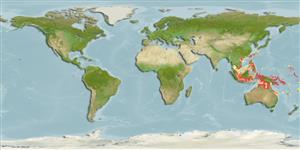>
Ovalentaria/misc (Various families in series Ovalentaria) >
Ambassidae (Asiatic glassfishes)
Etymology: Ambassis: Derived from Greek, anabasis = climbing up (Ref. 45335).
More on author: Hamilton.
Environment: milieu / climate zone / depth range / distribution range
Ekologi
laut; air tawar; payau dasar (demersal); amphidromus (Ref. 51243). Tropical
Asia and Oceania: India to New Guinea and Australia (Ref. 40509).
Size / Weight / umur
Maturity: Lm ? range ? - ? cm
Max length : 12.5 cm TL jantan/; (Ref. 7050)
Usually found in brackish waters of bays and estuaries, entering freshwater and mangrove-lined tidal creeks (Ref. 4833).
Life cycle and mating behavior
Kematangan | Reproduksi, perkembang biakan | Pemijahan | telur-telur | Fecundity | Larva
Paxton, J.R., D.F. Hoese, G.R. Allen and J.E. Hanley, 1989. Pisces. Petromyzontidae to Carangidae. Zoological Catalogue of Australia, Vol. 7. Australian Government Publishing Service, Canberra, 665 p. (Ref. 7300)
Status IUCN Red List (Ref. 130435: Version 2024-1)
ancaman kepada manusia
Harmless
penggunaan manusia
Alat, peralatan
laporan khas
muat turun XML
Sumber internet
Estimates based on models
Preferred temperature (Ref.
123201): 26.4 - 29, mean 28 °C (based on 550 cells).
Phylogenetic diversity index (Ref.
82804): PD
50 = 0.5000 [Uniqueness, from 0.5 = low to 2.0 = high].
Bayesian length-weight: a=0.01202 (0.00496 - 0.02912), b=3.02 (2.83 - 3.21), in cm total length, based on LWR estimates for this Genus-body shape (Ref.
93245).
Trophic level (Ref.
69278): 3.4 ±0.4 se; based on size and trophs of closest relatives
Daya lenting (Ref.
120179): Tinggi, Waktu penggandaan populasi minimum kurang dari 15 bulan (Assuming Fec > 10,000).
Fishing Vulnerability (Ref.
59153): Low vulnerability (10 of 100).
